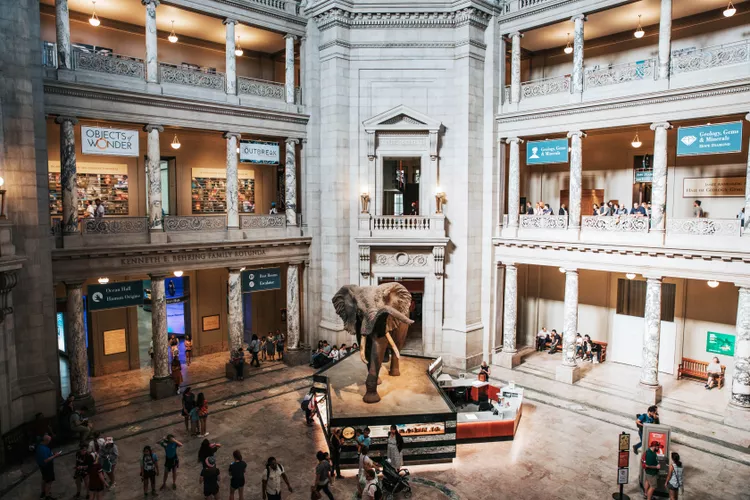Summary
10th St. & Constitution Ave. NW, Washington, DC 20560, USA
Phone +1 202-633-1000
The National Museum of Natural History is part of the Smithsonian Institution and houses a national collection of more than 125 million natural science specimens and cultural artifacts. Located on the National Mall in Washington DC, this museum is the most visited natural history museum in the world. It is also a research facility dedicated to inspiring discovery about the natural world through its exhibitions and education programs. Admission is free.
The National Museum of Natural History is a favorite with kids but has plenty to intrigue all ages. Popular displays include dinosaur skeletons, an enormous collection of natural gems and minerals, artifacts of early man, an insect zoo, a live coral reef, and much more.
Visiting Tips
This is the most popular Washington DC museum for families. Arrive early in the morning or late in the afternoon to avoid crowds. Moreover, here are some tips to make your trip go as smoothly as possible:
- Purchase IMAX tickets in advance or as soon as you arrive.
- If you are visiting with kids, be sure to save time for the Discovery Room, where there are lots of hands-on activities.
- Allow at least 2-3 hours for your visit.
Address
10th Street and Constitution Ave., NW
Washington, DC 20560 (202) 633-1000
The closest Metro stations are Smithsonian and Federal Triangle.
Museum Hours and Tours
Open daily except December 25. Regular hours are 10:00 a.m. to 5:30 p.m. The museum extends their hours during the summer months. Please check the official website for updates. Free weekday highlight tours begin in the Rotunda, Monday through Friday at 10:30 a.m. and 1:30 p.m., September through June.

“Must See” Permanent Exhibits
The National Museum of Natural History offers several permanent exhibits on a variety of topics that engage and inspire all ages.
- The Janet Annenberg Hooker Hall of Geology, Gems, and Minerals: The hall showcases the famous Hope Diamond and other treasures of the National Gem Collection.
- Hall of Human Origins: The exhibition tells the story of how the human species evolved over 6 million years, including more than 285 early-human fossils and artifacts, lifelike full-size reconstructions of hominid species, and 23 interactive experiences.
- The Sant Ocean Hall: This one-of-a-kind interpretive exhibition demonstrates how the ocean connects to other global systems and the daily lives of people around the world. See male and female giant squids and an exact replica of a living North Atlantic right whale.
- Butterflies + Plants: Partners in Evolution: Visitors get an up-close look at how butterflies and plants have evolved and diversified together for millions of years.
- The Last American Dinosaurs: This exhibit features a giant, plant-eating Triceratops, a 14-foot-tall cast of a T. rex, murals of ancient environments, a video presentation, and an arcade-style game, “How to Become a Fossil.” The museum is designing a new National Fossil Hall, the largest, most extensive exhibition renovation in the museum’s history.
- O. Orkin Insect Zoo: The room offers various hands-on activities and live insects on display, as well as daily tarantula feedings.
- Kenneth E. Behring Family Hall of Mammals: Over 270 mammals and dozens of fossils are showcased in various environments.
Dining at the National Museum of Natural History
The Atrium Café provides fast food options, and the Fossil Café features soups, sandwiches, salads, Gelato, and an Espresso Bar. If you are still hungry after your visit, don’t fear: there are plenty of restaurant and dining options nearby.





